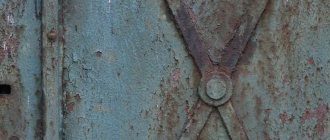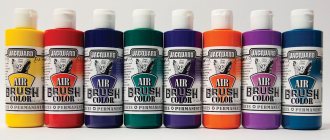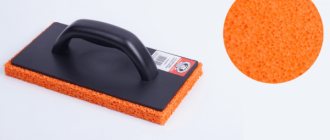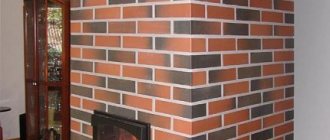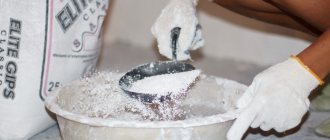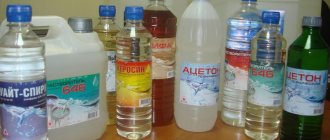In order for the garage to have a neat and finished appearance, it should be painted. Since each type of surface requires the appropriate paint and varnish material, you should first decide what types of paint you need to put your garage in order.
In principle, anyone can independently carry out exterior and interior painting. However, when choosing paint, it is worth considering the material from which the garage is built. If the walls are built from foam blocks, bricks or concrete slabs, then they must be plastered before painting, since putty is not suitable. This is due to the fact that the putty disrupts adhesion and the paint will not adhere to the surface.
Painting a metal garage
A metal garage without proper protective coating will quickly rust and become unusable. Therefore, when deciding which paint to choose for your garage, you must consider the following requirements:
- the paint coating must contain anti-corrosion additives;
- good resistance to temperature changes;
- resistance to humidity and aggressive atmospheric influences;
- quick drying of the paint layer.
The most popular in this regard are enamel paints, which have all of the above characteristics and will provide reliable protection for the metal surface of the garage for a long time. And the most common are silicone and alkyd enamels, which, however, are beginning to give way to more modern water-based acrylic paints. Due to their versatility, paints can be used for both exterior and interior painting.
Acrylic coatings, unlike organosilicon and alkyd compositions, do not contain solvents, as a result of which they are fire and environmentally safe. Regardless of the paint chosen, the surface must be primed.
Important! Experts recommend purchasing primer and paints from the same manufacturer. Thus, the quality of the coating is greatly improved.
Completing of the work
Then you can proceed directly to the work, which consists of several stages:
- The most important point is the purchase of material. First, you should find out how much the chosen paint, primer, remover, solvent, and so on will cost. After all, the price of finishing will largely depend on the components
- We prepare the tools: brush, roller, if required – stepladder, sprayer, paint container;
- If the garage has previously been painted, the old coating must be removed. This can be done using a drill with an abrasive attachment or a metal brush, wash and a hair dryer.
- After this, sand the metal with emery cloth;
- The surface is then degreased on its own using a solvent.
- The metal is primed. This will help improve the adhesion of the base and paint and protect the entire surface from corrosion. The primer will also make the base level, which improves the quality of painting.
- Once the primer is completely dry, the surface is washed with water. This is necessary to remove dust and dirt.
- Painting the walls with a roller is done from top to bottom strictly in a vertical direction. This makes it much easier to remove drips if they appear. A spray bottle can help with this job. Then the dye will penetrate into all inaccessible places and the coating will last much longer.
Attention: The instructions say to apply each strip, slightly overlapping the previous one. In this case, the coloring will be uniform, without any transitions or omissions.
- Complex areas such as corners and edges are painted with a brush. After twenty-four hours, the coating will dry and you can apply another coat of paint. This is done in a horizontal direction.
Paint for brick and concrete buildings
The best paint for a garage made of similar materials - all types of brick, concrete - should be polymer-based.
Each type of such compositions will have its own advantages:
- Epoxy primer-enamels are applied without a preliminary primer base for painting;
- Perchlorovinyl paints tolerate low temperatures well;
- Water-emulsion acrylic compositions can be applied to freshly laid concrete, as well as plaster. Among other things, they have good weather resistance;
- Polyurethane paint for concrete has increased wear resistance and chemical resistance.
Polymer coatings can be used not only outside the room, but also inside it. If necessary, they can be painted in any tones and shades.
For these purposes, pastes and tinting paint are used. The compositions will most reliably protect concrete walls, ceilings and floors from aggressive environments, moisture and mechanical loads. Special paints are designed to increase the service life of the base and strengthen it.
Painting a metal garage is not a complicated process, but it is quite painstaking. There's no need to rush. Make sure the surface is properly prepared. The instructions will help you not to miss anything, and after looking at the photo and drawing up a work plan, you can start working on it.
The choice of paints and varnishes for garages made of brick, foam blocks and concrete slabs
The most optimal paint and varnish materials for painting a garage made of concrete, brick or stone are polymer-based paints. Moreover, each variety has its own advantages:
- epoxy primer enamels can be applied without prior priming the surface;
- perchlorovinyl compounds are highly resistant to low temperatures;
- polyurethane paint for concrete has high wear resistance and resistance to chemicals;
- water-based acrylic coatings can be applied even to fresh plaster and have high weather resistance;
- polymer paints can be used both indoors and outdoors;
- For outdoor work, quick-drying nitro enamels are best suited.
Choosing a color
Despite the existence of hundreds of shades, the ability to mix, match and combine them as you like, the problem of what colors to paint the garage does not lose its relevance. In essence, it comes down to choosing from several options the one that suits the worldview, the design of nearby buildings or the owner’s vision.
It is better to adhere to the rule of the golden mean - neither white, nor black and not luridly flashy colors. After all, a garage is not painted every day; the chosen shade should not cause irritation and the desire to immediately change it to another.
A calm, moderately saturated color, evenly applied to the walls, will optimally satisfy the customer’s expectations.
Paint for concrete floor in garage
Most people believe that staining a concrete garage floor is not practical. However, concrete is also susceptible to various elements, and painting it will give the floor additional protection.
Basically, for painting concrete floors in garages, alkyd and epoxy paints are used, which have high anti-slip and antistatic characteristics and high resistance to chemical reagents. Epoxy compositions must be mixed before use, while alkyd paints are sold completely ready for use.
Attention! Before painting a concrete floor with alkyd paints and varnishes, the surface should be primed, whereas this is not required when using epoxy compounds.
Conclusion
To choose the right paint for your garage, you need to take into account the material of its construction. The characteristics of environmental influences should also be taken into account. By watching the video in this article, you will gain a lot of useful knowledge.
Similar articles
- Roofing paint: features of finishing metal roofing coverings, video, photo
1 Types of roofing paints 1.1 Rubber paint 1.2 Thin-film galvanizing 1.3 Fire retardant paint 2 Conclusion The roof serves as protection for the entire house and its… - How to paint metal: what to treat before painting, painting instructions, video and photo
1 Overview of suitable paints and varnishes 1.1 Primer 1.2 Types of paints depending on their base 1.3 Division into types according to special… - Painting metal: painting sheet products and others, instructions on how to paint, video and photos
1 Main stages of work 1.1 Purchase of materials and tools 1.2 Surface preparation 1.3 Paint application 2 Conclusion Metal structures are widely…
Painting a concrete floor
Before painting the garage floor, you need to prepare the concrete base. To do this, the surface is cleaned of dust and dirt, uneven areas are sealed with putty or mortar, and only then paint is applied.
The paintwork should consist of 2-4 layers. The paint is applied at a temperature of the treated substrate not lower than +5˚C, ambient temperature not lower than +10˚C and air humidity not higher than 80%. Concrete floors can be painted no earlier than 5 days after pouring. The next coat of paint should be applied only after the previous one has completely dried, which is usually about 24 hours.
When choosing paints and varnishes for painting a concrete garage floor, you should definitely take into account the ability of the paint composition to withstand a wide variety of temperature changes, resistance to long-term high loads and other operating features typical of a garage.
Coating technology
Spray painting
If you are thinking, for example, about how to paint an iron garage or other metal structure, then you should definitely know that this procedure should consist of three main stages of work, the order of which must not be disturbed:
- Preparatory work;
- Application of primer;
- Coloring.
Preparing metal for painting
Brushes for removing a layer of old finish
Iron rust paint with anti-corrosion additives or regular iron paint cannot be applied directly to old, uncleaned trim. The surface to be painted must be properly prepared.
Note! The quality of material preparation can affect the durability and aesthetic characteristics of the created coating.
The essence of surface preparation lies in cleaning and removing everything unnecessary from it.
This process consists of the following stages of work:
- Remove debris and dust from the surface;
- Remove rust and old paintwork from the surface , if any. For this purpose, you can safely use a scraper, a metal brush, sandpaper and even a metal dishwashing sponge;
- Remove stubborn dirt, dust, grease stains , etc.
Advice. To remove stains of dirt and grease, do not use abrasives; it is better to treat the surface with a soap solution.
If large areas are intended for painting, it would be advisable to use a gas burner. The flame of such a device will burn the paintwork, and the remaining scale and rust will peel off easily after treatment.
Many people are concerned about the question of how to paint rusty iron? The preparation of such material can be done using rust converters. In this case, the product is lubricated with the product and after some time it is washed and dried.
Advice. In cases where rust cannot be dealt with, paint with anti-corrosion characteristics should be used.
Padding
Priming rusty metal
A primer is a composition that allows you to protect metal from aggressive environmental influences, and these compositions also function as rust converters. In addition, the primer allows you to increase the adhesion of the created finish. Apply primer to the prepared surface.
Applying the primer yourself can be done in any way convenient for you - pouring, spraying, brush, roller, etc.
Painting metal
The next stage is applying paint.
This process should be carried out taking into account the following recommendations:
- Products with fairly complex shapes should be painted with a brush;
- The paint should be applied in 2-3 layers;
- Small areas can be tinted using an aerosol can, applying a coating of 4 or more layers;
- It is more advisable to paint large surfaces using a roller, diluting the paint with a solvent. Roller painting requires a minimum of 2-3 coats of paint.
Whatever painting method you choose, you need to remember that before applying each subsequent layer, at least 3 hours must pass so that the paint does not harden.
Painting the walls
The optimal solution for painting garage walls are silicate paints and varnishes, which are made from potassium glass. Such coatings do not fade, are abrasion resistant and durable. Used for painting brick, stone, concrete and plastered surfaces.
Polysilicon compositions based on silicone resins are considered even better to use than silicate paints. They hold up well even on organic plaster. Such paints allow air to pass through and retain moisture. The only drawback is the relatively high cost of this paint and varnish material.
However, the most common for painting the interior surface of garage walls are water-dispersed paints based on acrylic organic resins. Such paints and varnishes repel dust and dirt, but are not used for painting silicate and limestone surfaces.

